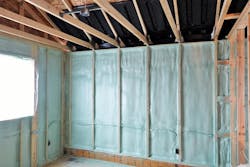If you’ve heard of spray polyurethane foam (SPF) insulation, you may have heard conflicting things about the material’s application and performance. In fact, some of this information may have made you hesitant to use it.
But, how much of what you’ve heard is based in fact? How much of it is word of mouth? To understand more, it’s time to go back to the basics.
Spray foam 101
To better understand spray foam insulation, it’s important to know that there is more than just one type.
For residential applications, low-density open-cell foam and medium-density closed-cell foam are a builder’s go-to options. While both SPFs offer thermal performance (R-value) and work as their own air barrier, medium-density closed-cell foam offers more benefits.
“Low-density open-cell foam is comparable to standard insulation you can find in most walls, but the difference is SPF acts as its own air barrier, creating a tighter building envelope,” said Chris Rosemond, Construction Science Architect at BASF.
“But if you compare closed cell foam to open cell foam, the differences are pretty exceptional. Not only do you get an air barrier like open cell, but closed cell nearly doubles the R-value. It also functions as its own Class II vapor retarder, is the only FEMA-approved flood-damage resistant insulation material, and adds structural strength in a way that other options can’t match,” says Rosemond.
If SPF has these benefits, why aren’t more tract builders using it to insulate their builds?
Rethinking assumptions
Hesitation to adopt building materials such as SPF are often the result of not having enough information. A common assumption is that site inspectors won’t approve it in certain assemblies.
“In my experience, the idea that inspectors will automatically say no to SPF is unfounded,” said Rosemond. “With BASF’s spray foam assemblies like unvented attics with Enertite G open cell and the HP+ Wall System with Walltite® HP+ closed cell, we partner with the builder through the entire process and provide all the necessary documentation any inspector might need to verify a build’s thermal and structural ability to satisfy code.”
Another common assumption about SPF is that it poses a health hazard.
“While home renovation shows have highlighted some pretty bad SPF installations, it still comes down to the application itself. For us at BASF, we ensure those that apply our SPF are not only trained but certified to do so. As for the perception that spray foam can cause health issues over the long term, that isn’t true. Once proper application procedure and curing of the SPF material occurs, in addition to ventilation of the structure, components and particulates would no longer be present and the SPF becomes inert. It’s just like filling a wall cavity with memory foam pillows,” says Rosemond.
In fact, all of BASF’s spray foam formulations are UL Environment Greenguard Gold certified for low-VOC emissions and meet the Spray Polyurethane Foam Alliance’s (SPFA) updated Environmental Product Declaration (EPD).
Yet, there is still one consistent objection to SPF— the perception that it carries a hefty price tag.
Expensive? It doesn’t have to be
We know that staying competitive in the residential building industry means keeping costs down. The thought of using an expensive new building material is a hard “no” for most builders. But, for Rosemond, using SPF means looking at the total cost to build a little more closely.
“Yes, SPF tends to be a more expensive insulation compared to traditional insulation. But when SPF like medium-density closed-cell foam acts as its own air and moisture barrier, vapor retarder, and provides structural strength to the whole build, suddenly you’re doing more with less,” says Rosemond.
Using SPF to insulate homes means needing fewer materials to meet code. One can avoid two-by-six constructions, reduce or eliminate oriented strand board (OSB) sheathing, downsize heating and air conditioning equipment, and require less control layers such as vapor retarders or air barriers.
“With all the added benefits of SPF, we’re seeing some builders actually save money on their builds, or at least keep their builds cost neutral,” said Rosemond. “Not only does SPF let builders remain competitive, they further benefit by potentially reducing warranty claims and callbacks for everything from mildew to drafts and frozen pipes while the home buyer benefits from better durability, air quality and comfort. Everyone wins.”
But to really embrace the competitive advantage that SPF can provide, it’s important to think like the smaller builders.
Taking a page from the little guys
Comparing tract builders to small custom builders, it’s easy to see that small builders are more agile when it comes to adopting SPF and new building methods.
“With increasing energy code requirements, small builders are able to shift their building methods quickly to meet demand while anticipating energy code changes that will require better energy efficiency,” said Rosemond. “We’re also seeing more educated customers who have a better understanding of what it means to have an energy efficient home. The more people know, the higher the demand gets and we want to help tract builders meet that demand.
“With our BEYOND.High Performance approach, we partner with builders and stay involved at every step of the build to show them exactly what it means to build beyond code for a sustainable future,” says Rosemond.
To learn more about BASF’s spray foam systems and other building materials and methods, including the BEYOND.High Performance approach, be sure to visit BASF outside in the Professional Builder's Show Village at the International Builders’ Show from February 19 – 21, 2019.

